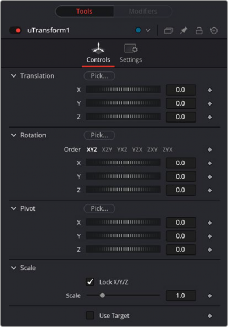
< Previous | Contents | Next >
Affects the amount of light reflection and scattering on a surface, giving it a smoother or more textured appearance depending on the setting. It is a key element in creating realistic reflections.
Affects the appearance of a surface by adding a glossy layer on top of it, mimicking the effect of a protective coating. It is commonly used in creating materials like car paint or polished metal.
Adjusts the level of imperfection or smoothness of the glossy layer added on top of a surface. This can affect the realism and reflection of materials like car paint or polished metal.
Reduces the material and object opacity, impacting the color and Alpha values of the shape.
Common Controls
The Transform and Settings tab in the Inspector is also duplicated in other USD nodes. These common controls are described in detail at the end of this chapter in “The Common Controls” section.
uTransform [uXf]

![]()
The USD Transform node
uTransform Node Introduction
The uTransform node is the same as a Null node in 3D; it will transform objects in a scene. Translation, rotation, and scale are the basic transforms supported, as well as Pivot location and target location for rotation.
Inputs
The uTransform node has a single required input for a USD scene or USD object.
— Scene Input: The orange scene input is connected to a USD scene or USD object to apply a second set of transformation controls.
Basic Node Setup
The uTransform node adds 3D position, rotation, and pivot control onto any existing transforms in the USD node prior to it. You can combine multiple uTransform nodes together to build parenting or hierarchical movement.

The uTransform node gives you another set of 3D transform controls that can be used to modify those in the Transform tab on the uShape node.
Inspector

![]()
The USD Transform controls
Controls Tab
Transform controls are used to position the USD shape in 3D space.
Use these buttons to select the order used to apply the rotation along each axis of the object. For example, XYZ would apply the rotation to the X-axis first, followed by the Y-axis, and then the Z-axis.